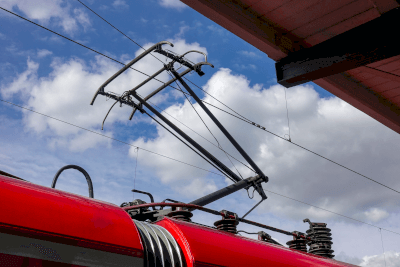What Is a Current Collector?

A current collector is a device used to supply electricity from an electric wire to a train or other transport device while it is running.
It is used as a power feeder for cranes, hoists, etc. in factories. Trolley wires are placed on the ceiling or sides of the track of the transport equipment, and current collector wheels and shoes are connected to the trolley to collect the power.
There are various types of current collectors, including pantographs commonly used on trains, pole collectors for cranes and hoists, and trolley poles.
Uses of Current Collectors
Current collectors are primarily used in self-propelled industrial and commercial equipment. Specific uses include the following:
- Overhead cranes and hoist cranes in factories
- Bullet trains and linear motor cars
- Trams and subway trains
- Self-propelled transport robots in factories
They are mainly used to move heavy machinery and equipment on a constant track. Current collectors require wires to be stretched, so they can only be used on predetermined tracks.
Principle of Current Collectors
Current collectors consist of the following parts: current collectors, arm, and insulator.
1. Electron Collector Part
The current collectors are the part that actually contacts the bare wire. It contacts the current-carrying point and conducts electricity. For this reason, alloys such as copper, tin, and carbon, which conduct electricity easily, are used. Since it is worn by contact, it needs to be replaced periodically.
2. Arm Bar
The arm bar is the part that supports the electron collector while pressing it against the bare wire. A spring is used to press the current collectors against the wire. It is characterized by the fact that it has some play to cope with the impact of running.
3. Insulator
The insulator prevents this voltage from being applied to the traveling equipment. If voltage is applied to the running gear, it is very dangerous because it can cause equipment failure or electrical shock. Insulation by insulators prevents such accidents.
Types of Current Collectors
There are various types of current collectors, of which pantographs, pole collectors, and trolley poles are three typical examples.
1. Pantograph
Pantographs are applied to various types of rolling stock and are the most common type of current collectors. There are two main types: the wheel type and the shoe type.
The wheel type collects power when the wheel contacts the overhead wires and has high arc resistance. On the other hand, the shoe type has a plate-shaped shoe in contact and provides a stable supply.
2. Pole Collector
The wheel of the pole collector makes contact with the bare trolley wire and collects power.
3. Trolley Pole
These current collectors were often used in trolleybuses and railroads in the past. It is made of iron or other metal pipe and energizes when the trolley wheel at the end comes into contact with an overhead line. Although the structure is simple, the number of trolley wheels is on the decline because of their tendency to separate from the overhead wires. It is applied to cranes in factories.
Other Information on Current Collectors
1. Reasons for Using Current Collectors
Trains run by rotating motors that use electric energy. There are many vehicles in the world, but it is surprisingly unknown that trains are the only vehicles that do not carry their own energy.
The reason for this is the performance and distance that trains can travel. If you want to run a heavy vehicle for a long time and over a long distance on electricity, batteries do not have enough energy capacity. A generator would be excessive, and energy for power generation would have to be provided separately. Therefore, if the vehicle is to be operated over a long distance, it must be replenished along the way.
Due to the above limitations, it was determined that the most efficient way to get electricity is to take it from an overhead line that has been electrified. Based on this idea, current collectors were invented as devices to collect electricity from overhead wires.
2. Changes in Current Collectors
Current collectors have been used in electric trains since their commercialization, including Japan’s first commercial train, which opened in 1895. The current collector at that time was a trolley pole with a single pole, which was replaced by a trolley pole with two poles when the two-wire overhead system was introduced.
However, the trolley pole must be manually operated by the conductor at junctions to prevent derailment. The pole must also be raised or lowered when changing the direction of travel. Therefore, as technology advanced, trolley poles gradually fell into disuse. As time progressed, view gels and pantographs were introduced to solve and improve various problems related to overhead wires and operation. Today, pantographs are widely used, and in Japan, pantographs are used almost exclusively.
When pantographs were first introduced, only foreign pantographs were available, but after much trial and error by domestic manufacturers, domestic pantographs became the mainstream. Even now, improvements are being made to improve the functions and performance of pantographs.